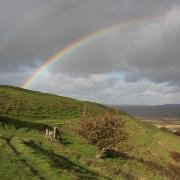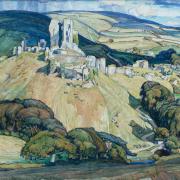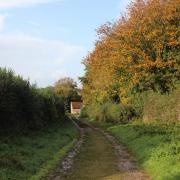When I moved to beautiful West Dorset seven years ago, I expected to meet lots of new people. What I never expected was to get to know a genuine bona fide saint.
Although I was already ordained as a priest, I didn’t only move to the Golden Cap Benefice for a vicar’s job. I came because I fell in love with the area, and I felt a strong sense of being called home. At the time I was working for a large international relief and development charity in London and commuting every week. So, having seen the light, I arrived in West Dorset not knowing what or who was waiting for me.
It turned out, it was St Wite (pronounced Witta) Dorset’s patron saint, whose festival day is June 1; St Wite’s Cross also features on the county flag. Her holy shrine is embedded in the wall of the church of St Candida and the Holy Cross in the village of Whitchurch Canonicorum, one of the 12 churches in Lyme Regis, Charmouth and the Marshwood Vale that I now have the great joy and privilege of ‘looking after’ as a half time Team Vicar.

Who was St Wite?
Getting to know this mysterious saint who lived here 1,200 years ago has become a journey of discovery. The more St Wite is spoken of, the more people come forward with stories of her past and her influence in the present. St Wita was a Saxon holy woman, a leader, a healer and watchman martyred by Danish Vikings during a 9th Century raid on neighbouring Charmouth. History tells of a significant landing of around 15,000 Vikings and of the battle of Chardown Hill in 831.
It is thought it was during this battle, as she fought to protect her community in the name of her God that St Wita was martyred. To honour her as a saint, King Alfred the Great built the first church dedicated to St Wite to house her relics, just 50 years after her death. The site was so valued by the King that on his death in 899, he passed the church and the surrounding land to his son, Æthelweard. In his will, King Alfred called the place ‘Hwitancircian’, showing the association with St Wite from the very beginning. It was the Normans, after the Conquest, who renamed the church, St Candida (Latin for St Wita).

With such an auspicious start, the presence of the St Wite’s shrine has attracted attention throughout the centuries from nobility and the Church alike. Consequently, various theories have been put forward about who St Wite was, these include a princess from Brittany, who was also called St Blanche or St Gwen Teirborn, meaning three breasted, on account of raising three families fathered by three consecutive husbands. The story goes that her bones were brought to Dorset by refugees from Brittany, following Viking invasions in the mid 10th century. However, in the old Roman martyrologies, St Wite is honoured as a virgin martyr killed for her faith; whereas St Gwen was the mother of many children and is known to have died of natural causes.
Another theory suggested that she was a man, a monk called Witta who accompanied St Boniface of Crediton on a mission to Germany. St Boniface and his companions were massacred in 755, but it is well documented that Witta was not among them. We can swiftly discount this theory as one of the few facts we do know about St Wite is that the bones in the shrine are that of a middle-aged woman.
This was discovered in 1899. During a very harsh winter and the ground shifted beneath the north wall of the church under the shrine, which cracked the stone sarcophagus. The Victorians could not resist looking inside and when they did, they discovered a lead casket with the inscription saying ‘+HIC. REQESCT. RELIQUE. SCE.WITE - Here rests the relics of St Wite’. This casket was opened in the presence of a medically qualified doctor who was able to confirm that inside were the bones of a small woman who was around 40 years old when she died.

This ‘disturbance’ in 1899, is the only one on record, which is surprising because one of the many miracles that surround St Wite is how her shrine and relics remained intact during the upheaval of the 16th and 17th century religious Reformation in Europe.
This makes St Wite’s shrine close to unique. That her bones remain in the church that bears her dedication during those turbulent times was no doubt due to being hidden in the heavily wooded and marshy Marshwood Vale. There is only one other saint in the whole of England who has a similar notable history to tell, King Edward the Confessor, whose shrine is in Westminster Abbey. Perhaps we can understand why the Reformers stayed their hand at the tomb of a King of England. But St Wite?
A story that has recently come to light is that locals, in fear of what might happen to their beloved Saint, lifted the stone sarcophagus containing the lead casket off its plinth in the church and moved it to The Shaves Cross Inn for safe keeping. (In medieval times, pilgrims would stop at The Shave Cross Inn to rest and have their heads shaved as an act of penance and preparation before making their way to St Candida and the Holy Cross, often on their knees for the last couple of miles.) Locals thought that the last place the Puritan Reformers would look for a saint would be in a pub cellar!

A Modern Pilgrimage
What I find so extraordinary about St Wite is that her shrine has been a site of pilgrimage and healing for well over a thousand years and still is today. Many people come to experience the peace and the sense of sacred presence in the church. Visitors and pilgrims leave prayer requests on cards in the three apertures of the shrine, asking for comfort, healing and hope for themselves and their loved ones; others return to give thanks for prayers answered. We pray through every request and expression of gratitude. All of life is there, from all ages, from all over the world.
It is deeply moving to be able to pray and give thanks for the healing that people have experienced in their lives, and to recognise the touchpoint with the sacred that has happened for them at the shrine. In recent times we have given thanks for the birth of babies, remission from cancer and for the healing of eye complaints, something that St Wite is renowned for. It is a privilege and a joy to pray such prayers.

In recent times, there has been a resurgence of interest in deep stories of faith and a growing interest in pilgrimage, with many searching for an opportunity to reconnect with their spirituality in fresh ways. Being in such an unusual and blessed position of caring for the patron saint of Dorset’s holy shrine, it seemed only natural that our church offers guided pilgrimage experiences inspired by the example of St Wite, taking in the sacred presence in the church and the surrounding coast and countryside, where heaven feels very close. These pilgrimage experiences are called St Wite’s Way.
Most of our experiences are a day long. They are open to all, of all faiths and none. These wellbeing days offer people the opportunity to connect with their spirituality through walking, reflection, storytelling and meditation, all in the glorious countryside of the Marshwood Vale. Literally walking in the footsteps of St Wite, in the place where she ministered, practised healing and was martyred for her faith. Last summer was our first season, and we had brilliant feedback from the pilgrims who joined us, with a surprising number saying, even months later, that something profound happened to them as we walked.

We also offer residential experiences for those who want to spend more time in reflection and to learn from each other. One of our pilgrim guests last year, said how they were able to reconnect with forgotten parts of themselves and through this experienced some healing. Wonderful. The first residential this year is at the beginning of June, where we will walk the main St Wite’s route, there is also one in October when we will be hosting a Healing Retreat.
New, for this year is our first Arts Pilgrimage on June 22. We are fortunate to be working with Clare Trenchard, one of our celebrated Dorset artists and sculptors, using drawing as a route to connect with our spirituality through creativity. Called ‘Catching the Light’ no previous drawing experience is required.
Do come and join us on one of our walks or events over the summer. St Wite looks forward to welcoming you soon.
Find out more or make a booking at stwitesway.org. Follow on Instagram @revdvirginia

Following the Golden Way
The Golden Way is an 8-mile walk, at the heart of St Wite’s Way, which starts and ends at St Wite’s Holy Shrine in Whitchurch Canonicorum. It visits sacred sites that are part of her story including Golden Cap, the highest point on the south coast, the atmospheric ruins of St Gabriel, and St Wite’s Well, known for its healing waters. As we walk, we talk and occasionally stop to hear more of her story and to reflect and connect with our spirituality. More routes are planned for next year, including one over Stonebarrow to Chardown Hill, the site of the battle where St Wite was martyred. Coming next year too is our first virtual pilgrimage where we can share experiences with those who are not able to be with us in person. Email ask@stwitesway.
Golden Way Dates: July 26 and August 9 & 23. Book at stwitesway.org/tickets or use this QR code to go to the booking site.



























